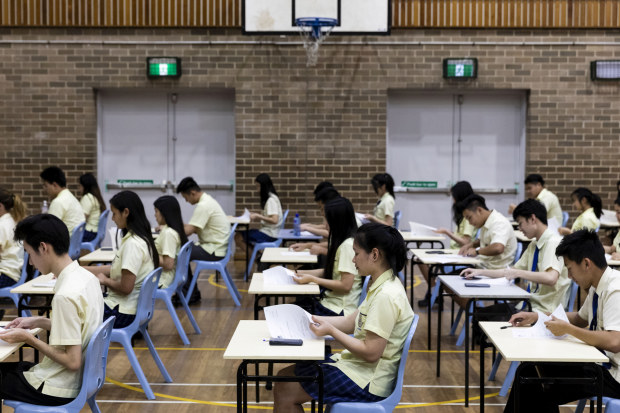Opinion

A chance to fix the inequity chasm in Australian schools
A report handed to education ministers last week has outlined a plan for real change after decades of reforms that have failed to bite.
Doug TaylorCharity leaderThe release of the individual school results from the 2023 NAPLAN data last week again highlights the equity gulf in our school system.
We already know that the NAPLAN results show about a quarter of school students from low socio-economic backgrounds needed additional support to meet minimum literacy and numeracy standards.

Australian students experiencing disadvantage are, on average, about five years of schooling behind their more advantaged peers. Dominic Lorrimer
Now the assessment of NAPLAN data by the Australian Curriculum Assessment and Reporting Authority shows the split between regional and remote versus urban schools: 101 of the 154 top-performing schools listed are in big cities.
First Nations students and students from regional and remote areas fared particularly poorly among those being left behind.
The analysis is a reminder that despite the best efforts of teachers and school staff, the education system is failing to meet the needs of all students.
These results were underscored by this month’s triennial OECD Program for International Student Assessment (PISA), which highlighted the divide between advantaged and disadvantaged students across Australia.
The assessment revealed Australian students experiencing disadvantage to be, on average, about five years of schooling behind their more advantaged peers.
About 70 per cent of students from disadvantaged backgrounds did not meet the national proficiency standard in maths, placing at risk their capacity to participate in and contribute fully to society. This compares to 28 per cent of those from advantaged backgrounds.
Our ‘last best chance’
For those working in our schools, the findings are not a surprise. But a report handed to education ministers last week has outlined a range of actions that could bring about real change after decades of reforms that have failed to bite.
The expert panel advising on the next National School Reform Agreement has highlighted the need for targeted and tailored support for those who need it, a commitment to fair school funding and the use of data and evidence to inform necessary changes, to help achieve equity in the education system.
The NSRA is the agreement negotiated between Australia’s federal, state and territory education ministers to set policy for schools, which then informs funding agreements.
This next NSRA has been dubbed by federal Education Minister Jason Clare as the “last best chance” to fix our schools.
Educational inequity has long been a feature of Australian schools, and PISA data shows it increasing over the past 20 years – exacerbated by the massive disruption caused by COVID-19. This is being compounded by significant cost-of-living increases.
The expert panel’s report, as an input to the NSRA, sets out a plan for change.
Among its recommendations is for public schools to be fully funded to combat inequality and for all students to be regularly monitored to identify the need for additional support.
On funding, the report said almost all public schools were not funded to the school resourcing standard introduced through the Gonski reforms to ensure funds follow the level of student need.
With more than 80 per cent of disadvantaged students attending government schools, we must ensure these schools are adequately funded and that schools with a large number of disadvantaged students are prioritised.
This would support the most disadvantaged schools to attract and retain the best teachers at a time of significant teacher shortages.
We now have a clearer picture of the areas that need greater focus to improve outcomes in our schools.
The report is also right in highlighting the need for a greater focus on direct and tailored intervention for those who are falling behind. This mirrors the programs we run at scale in Australia to help students in families experiencing disadvantage.
This tailored intervention is not only critical to help them catch up but also to keep up and stay engaged at school.
In the past few days, year 12 students have received their results. Research clearly shows that finishing year 12 makes a big difference to the life outcomes of a young person. It increases the likelihood of going on to further study or training, as well as entering the workforce.
It also leads to higher annual earnings for individuals and their families, greater community contribution, and economic benefits for the country.
Yet, we know that students from disadvantaged backgrounds are much less likely to complete year 12 than others.
We now have a clearer picture of the areas that need greater focus to improve outcomes in our schools. It makes it more critical than ever to get the next National Schools Reform Agreement right. That new agreement will start in 2025 and direct future federal, state and territory funding.
It will take funding directed towards evidence-informed initiatives, and it will take significant commitment stay focused on this – our young people are too important for us to fail.
Doug Taylor is CEO of the children’s education charity The Smith Family and a member of the National School Reform Agreement Ministerial Reference Group. The Australian Financial Review partners with The Smith Family to provide educational support for young disadvantaged Australians.
Introducing your Newsfeed
Follow the topics, people and companies that matter to you.
Find out moreRead More
Latest In Health & education
Fetching latest articles